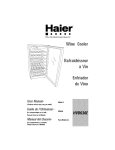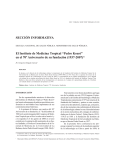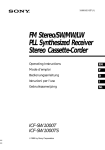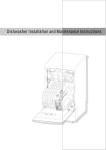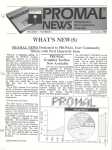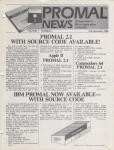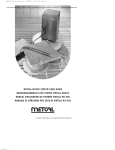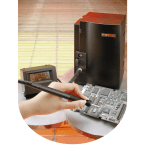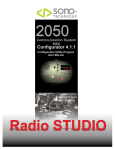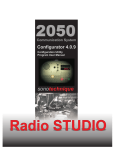Download 1lllllllllllllIllllllllllllllllllllllllllllllll||l|llllllllllllllllllllllll
Transcript
1lllllllllllllIllllllllllllllllllllllllllllllll||l|llllllllllllllllllllllll US005594733A United States Patent [191 [11] Patent Number: Katoen et al. [45] Date of Patent: [54] MULTI-STATION BUS SYSTEM HAVING MEANS FOR POLLING AND UPDATING OF GLOBALLY RELEVANT INFORMATION, IN PARTICULAR A STATION ADDRESS, AND 4,608,685 8/1986 Jain et al. ............................ .. 370/858 3/1989 Narayanan et al. .. 5,177,739 1/1993 Basnuevo et al. ................... .. 370/858 [75] Inventors: Joost-Pieter Katoen; Marnix C. Vlot, both of Eindhoven, Netherlands [21] Appl. No.: 943,368 [22] Filed: Sep. 10, 1992 Primary Examiner-Douglas W. Olms Assistant Examiner-Dang Ton Attorney, Agent, or Firm—Laurie E. Gathman Foreign Application Priority Data European Pat. OE. ............ .. 91202304 [57] ABSTRACT A communication system has multiple and uniformly Int. Cl.6 ................................................. .. H04L 1N403 US. Cl. ......................... .. 370/449; 370/410; 370/503 Field of Search ................................ .. 370/858, 85.1, weighted station interconnected by a shared digital bus. A particular station comprises globally relevant information, 370/855, 85.12, 95.1, 95.2, 95.3, 94.1, 94.2, 94.3, 60, 60.1, 100.1, 105.1, 105.4, 105.5, 107, 108, 110.1, 85.2, 85.3; 340/8255, 825.51, 825.06, 825.07, 825.08; 375/354, 355, 356, 359, 365, 366 and, with a predetermined maximum recurrence time, trans mits a data packet representing such item to any other interested station. If unanimous counter signalization occurs, the item is in order, other wise updating thereof is undertaken. The unanimity is either by positive signaliza tion, or by default. References Cited [56] Netherlands . “Single Chips 8—BitMicrocontrol1ers”, User Manual 1988, Philips Electronic Components and Materials Division. NY. [51] [52] [58] 10/1989 OTHER PUBLICATIONS [73] Assignee: U.S. Philips Corporation, New York, [EP] 370/852 FOREIGN PATENT DOCUMENTS 8900717 Sep. 10, 1991 Jan. 14, 1997 4,814,974 STATION FOR USE IN SUCH SYSTEM [30] 5,594,733 U.S. PATENT DOCUMENTS 4,387,458 20 Claims, 2 Drawing Sheets 6/1983 Carbrey .............................. .. 370/8512 12 SDAT(2) . 11 SDAT(1) I! ’ 32 22 \\ . ‘ - - TRANs . - ' DETECT INTERFACE C‘RCU'T 23 \ 42 \ TRANs DETECT INTERFACE CIRCUIT 33 \ \\ UPDATE MEM 31 \ \ \ DETECT INTERFACE CIRCUIT 43 \\ MEM 21 TRANs UPDATE \ MEM UPDATE 41 Z‘EPZAQTQEE, RECEJRDER (E.G., WASHING APPARATUS APPARATUS TELEvIsIoN MACH'NE' (E~G~. DRYER) MONITOR, TUNER) D‘SHWASHER) 2 3 (Sm) (station) 4/ (Station) \j 1 (I. I US. Patent Jan. 14, 1997 Sheet 1 of 2 5,594,733 12 SDAT(2) \_ , 11 SDAT(1) / 32 22 \ TRANS DETECT INTERFACE CIRCUIT 23 TRANS DETECT 42 \\ TRANS INTERFACE CIRCUIT 33 \ \\ INTERFACE CIRCUIT 43\\ MEM 21 DETECT UPDATE MEM 3‘ \ \ UPDATE 41 \ \ APPARATUS MEM UPDATE \\ APPARATUS (530x235? (E.G., WASHING APPARATUS TELEVISION’ MAcI-IINE, (E.G., DRYER) MONITOR, TUNER) D'SHWASHER) 3 (Station) (Station) (Station) FIG. 1 _|'sT WV4>4VAVA>X4VAVA>X4VAVAVA>EVAVA M0 MSA SSA Acr cFAcIrgns EnnAcIII us EUDACIII us EUU Acm I'—ncI=—-I-—ncF-I<—ucF—-I FIEZA ‘ I MSA/SSA T IfA_ 1 I US. Patent Jan. 14, 1997 ‘ START Sheet 2 0f 2 > /s1 /SZ /53 55 r56 Y FA —>FA+1 —-1 5,594,733 5,594,733 1 2 MULTI-STATION BUS SYSTEM HAVING MEANS FOR POLLING AND UPDATING OF GLOBALLY RELEVANT INFORMATION, IN PARTICULAR A STATION ADDRESS, AND STATION FOR USE IN SUCH SYSTEM initiates an updating action with respect to its own relevant information item. In particular, the originating station does not address the stations of the relevant subset, as the originating station may not know which stations are actually present in the subset but rather it would only know that a station which should have joined in the unanimous counter signalization, did not. If a unanimous counter signalization is not obtained then it means that the originally transmitting FIELD OF THE INVENTION station’s information was outdated or otherwise erroneous. The invention relates to a communication system having multiple and uniformly weighted stations that are intercon Thereupon, the original station begins updating. The unani nected by a shared digital bus. Such systems are in general use. Uniformly-weighted is understood as meaning that there is no single station present that acts as overall con troller of the bus interactions. On the level of a single mous counter signalization indicates, that all other stations are in unison about the original information item. In this way, the original station need not poll each station regarding the correctness of an information item. The original station instead puts the information item on the bus and if the original station does not receive a signal which indicates that the other stations are in unanimous agreement that the information item is correct then the original station will update or change the value of the information item there may, transfer, a ?rst station may operate as a master, whereas one or more second stations would operate as slaves. A subse quent transfer could then have a different master station. Moreover, the stations can have various different priority levels, activity frequencies, and hardware provisions. The bus as referred to supra is metaphoric for its medium, that is it may be single—(that is the bus at any time has only a 20 circumstances signal a discord), or wired-AND. The counter signalization could be a message, wherein the set of mes single data value) or plural channel, galvanically intercon nected, optical, radio broadcast, infrared, or other. The bus medium may be uniform or mixed, such as a wired inter connection, that has a two-way station for external commu 25 nication of infrared signals. The organization may have sages generated would indicate unanimity or otherwise. In this respect, all messages could indeed contain identical signalization items, whereupon the original station would check the unanimity. According to another solution, any provisions for AND-ing/OR-ing logical states generated by such message could, on a suitable communication layer, such as bit, word, or other, by its occurrence alone, signal lack of unanimity. Furthermore, the original station need not always transfer the item itself, as an indirect indication, abstract, or other representation would su?ice. It is not the bus-connected stations. In other organizations, such provision would be irrelevant. There are various uses for this bus system including home based systems for audio/video entertainment, home-environmental control (lighting, tem perature, humidity), devices for executing household chores, strictly necessary that all other stations connected should actually have the facility for counter signalizing. Certain stations could be slave-only stations. Alternatively, a station telecommunication, safety control, and others. A particular hazard of such a system is the low degree of organizational consistency on the level of the stations themselves, as may be too busy to answer and if it did not concur with the unanimity, it could signal so upon the end of the next exempli?ed by: a particular station may be temporarily deactivated because it is unplugged from the bus, switched-o?’ an associated main switch, by its main plug is discon nected, etc. Of course, the bus’ physical transport layer recurrence interval. Various other reasons could put a par ticular station out of the relevant subset speci?ed above. According to a particular advantageous aspect of the invention, the globally relevant information is an address of should be immune against such disruption, but higher the particular station itself. Generally, such addresses should be unique, and the updating would take care of making the protocol levels would at any rate be in?uenced; a particular message could go astray, which in particular address unique again. Many things could cause two or even could occur in case of an infrared or broadcast medium. This could cause various levels of inconsistency, in that certain stations could receive information that differs be various physical representations of the unanimity, such as by using a wired-OR (a -one- signal could in particular 45 more stations to have the same address, and the present invention would make the system stabilized again on a unique address for all stations that would observe the polling from other stations’ information, or could even be operation. Another example of globally relevant information totally absent; would be the value of the actual or real time. The invention at arbitrary instants, the bus system could become con would keep the actual value of such globally relevant nected to another bus system. Even if at each level of 50 information correct, even if the original station becomes the separate bus system, consistency would prevail, temporarily disturbed and does not know which other station such need no longer be the case on the level of the to address for acquiring the correct value. composite system. SUMMARY OF THE INVENTION Amongst other things, it is an object in the present If the original station broadcasts its own address as a 55 destination address, any other station responding thereto would mean non-unanimity with respect to other stations that would keep mum. This indicates that this address is invention to solve in particular, but not limited to home already assigned to another station and the original station systems, the above inconsistency problems in a convenient, must choose another address In this respect, the situation consistent and unencumbering manner. According to one of 60 that all stations had the same address is considered as degenerate. In practice, it will not occur. the invention’s aspects, a particular station comprising a globally relevant information item transmits, recurrently The updating may go according to a predetermined pat with a predetermined maximum recurrence interval, a data tern. For an address, successive incremental ions by one packet representing such information item for unanimous would be good. Alternatively, updating according to a counter signalization thereto by at least a relevant subset of 65 pseudo-random series would keep two updating stations apart from each other. Especially in a start-up situation actually interconnected stations thereto, but upon absence of such unanimous counter signalization the particular station where any station may start from a default address -zero-, 5,594,733 3 4 this would be advantageous: respective stations could then follow respective different sequences. After updating, the result of the updating may be signalled to any relevant station, either by repeating transmitting a data packet formatted like the original one, but with the now twelve-bit master station address is transmitted from the station wishing to transmit information to a destination station. The twelve~bit destination station address is trans mitted in the destination station address ?eld SSA. If a station recognizes the destination address as its own address, it transmits an acknowledge code in acknowledge code ?eld ACI. If this acknowledge code is not received, it means that the destination station is not present or does not function or that the destination station address is received in a mutilated updated information item, or by effectively addressing any station present, for example, by adding destination default address such as -zero-. This procedure keeps other stations abreast of any new developments. Advantageously, the system comprises a distinguishing 10 device for distinguishing among actual recurrence intervals of respective ones among said stations. Each station could have its own speci?c recurrence interval. Alternatively, the recurrence interval could be a time-variable quantity in any 15 relevant station. The invention also relates to a station for use in such communication system. Various advantageous aspects are recited in dependent claims. BRIEF DESCRIPTION OF THE FIGURES For a fuller understanding of the invention, reference is attached to the following description taken in connection with the accompanying drawings, in which: FIG. 1 shows diagrammatically the general structure of a single-channel communication system; ties. In these cases the communication is discontinued after the acknowledge code ?eld. If the acknowledge code has effectively been received, the master station transmits a control code of, for example four hits in control ?eld CF. After reception of this control code, the destination station again transmits an acknowledge code in acknowledge code ?eld ACII. If this second acknowledge code is not received by the master station, the communication is discontinued. If the master station has received this second acknowledge code a data ?eld DF occurs. The data ?eld may be divided into various data or command sub?elds, each containing a data byte DB, and end of data signalization EOD, and acknowledge bit interval ACHI. Absence of the latter may trigger repeat of the most recent sub?eld. If EOD is positive, 25 the transmission may terminate. The structure of a station address is shown at FIG. 2B. It comprises a service address SA, a type address TA and a FIG. 2a shows diagrammatically the structure of a com~ munication operation on an information level performed on the communication bus; FIG. 2b shows the structure of a station address; 30 FIG. 3 shows a ?ow chart for assigning a station address to a station. DESCRIPTION OF A PREFERRED EMBODIMENT General structure of the communication bus system FIG. 1 shows diagrammatically a single-charmel commu nication bus system. It comprises a communication bus 1 consisting of two data lines 11 and 12. In this case three stations 2, 3 and 4 are connected to this communication bus. form. No distinction is made between these three possibili follower address FA. The service address SA comprises, for example four bits and can thus distinguish sixteen services, for example an audio-video service, a washing service, a cooking/baking service etcetera. The type address TA com prises, for example ?ve bits so that thirty-two stations can be distinguished within one service. For example, within the washing service a distinction can be made between a wash 35 ing machine, a drier, a dish washer, etcetera and within the audio-video service a distinction can be made between a TV monitor, a tuner, a video recorder, etcetera. In practice the user may have a number of apparatuses of the same type, for example, two or more video recorders. Each station comprises an apparatus 21, 31, 41 which is The follower address FA enables him to distinguish between connected to the data lines 11 and 12 by means of an interface circuit 22, 32, 42. Such an apparatus may be a TV monitor, a video recorder, an audio recorder, an audio tuner, a controllable set of lighting elements, etcetera. The com munication bus is intended to transmit control signals from 45 these apparatuses of the same type. By three hits, eight a ?rst station to a second station. Some stations will act as master stations and others as slave stations. Some stations will act as transmitters of data, some as receivers. All kinds of mixed or alternating situations are possible. The commu nication operations on the communication bus, which will herein be described, are performed by the interface circuits. A particular advantageous realization of the bus is DZB, c.f. U.S. Pat. No. 4,429,384 that is single channel, twisted pair. apparatuses of the same type can be distinguished. The initialization Now, a station address comprises a service address, a type address and a follower address. The service address and the type address have been assigned by the manufacturer and are programmed in the station address memory of the interface circuit. Programming of the follower address is left to the user and does not take place until after the relevant apparatus has been connected to the communication bus 1 by means of the interface circuit. To this end this interface circuit has an initialization program with the steps shown in FIG. 3 and which is performed as soon as the apparatus is switched on. More particularly the follower address FA is set to zero in a referred to in: Single-Chips 8-Bit Microcontrollers, User 55 ?rst step 50. Subsequently the start bit ST is set on the The interface circuit may be a MAB 8051 microcontroller, manual 1988, Philips Electronic Components and Materials Division; Chapter 3: The MAB 805l/C5l/52 microcontrol ler family; Chapter 11: The DZB speci?cation. To distinguish the different stations, each interface circuit has a memory location 23, 33, 43 in which a station address is stored. A typical station address comprises twelve bits. The structure of a communication operation on an infor mation level is shown in FIG. 2A. Such an operation starts with a start bit ST. It is followed by a mode ?eld MO in which three mode indication bits are transmitted. They 65 indicate the rate at which the following information will be transmitted. In the master station address ?eld MSA the communication bus in step 51, the mode bits of the mode ?eld MO in step 52, subsequently the station address MSA of this station is set with FA=0 in step 53 and ?nally the destination station address SSA of the destination station with which communication is desired is set in step 54. More particularly, the destination station address SSA is made equal to the station address MSA of the master station. Waiting for an acknowledge code takes place in step 55. If this code occurs in the acknowledge code ?eld ACI (so that ACI=l), the follower address is raised by one in step 56 and the steps 51 to 55 are performed again. Whenever an acknowledge code occurs (ACI=1) this means that another 5,594,733 6 5 system, with a predetermined maximum recurrence station is connected to the communication bus which has the same service address, type address and follower address as the transmitting master station. If no acknowledge code is interval between recurring transmissions of the data packet; received, it means that none of the other stations has a station b) detecting means for detecting counter signalizations by address which corresponds to that of the master station. The UI last used follower address FA is then stored in the station address memory in a step 57, thus ending the initialization program. c) updating means for changing the information item in As described in the Reference, a master station does not get access to the communication bus until a so-called 10 arbitration procedure has been formed. In this arbitration procedure the mode indication hits, the service address bits response to a non-unanimous counter signalization from the subset of other stations, and wherein the counter signalization of each station is one of (i) a response by a station and (ii) no response by a station, and the non-unanimous counter signalization for a transmitted data packet is one of i) a response from less than all of the stations of the subset when all of the stations of the subset should have responded to the transmission of the data packet and ii) a response from and type address bits and now also the follower address bits are involved. The updating In a system according to the invention, the stop block actually starts a particular time-out, after which the system a station of the subset when none of the stations of the subset should have responded to the transmission of the again reverts to block 51, and the same procedure as for data packet. initialization ensues. A particular provision, not shown, may be taken in case the loop of FIG. 3 is cycled continuously, indicating no free address is available. For brevity this has not been shown in FIG. 3. A few assumptions are as follows: ?rst, any unit has a unique code D1 or some “random” generator for distinguish ing itself from units of the same sort. As almost any unit must contain some NVRAM already, this memory may also contain such code. The randomness of the randomness generator need not be extreme, inasmuch as any system a subset of the other stations; and 2. The communication system as claimed in claim 1, wherein the non-unanimous counter signalization for a transmitted data packet is a response from at least one of the stations of the subset which response is different than other responses from other stations of the subset. 3. The communication system as claimed in claim 1, 25 wherein after the information is changed by said updating means, the transrrritting means transmits to the other stations on the digital bus a data packet representing the changed information item. usually contains only a moderate number of stations, say less 4. The communication system as claimed in claim 1, than 50. Further, as long as a unit has not gained an address 30 wherein each station including transmitting means transmits de?nitely, that is, when the unit has not yet decided which the data packets such that the predetermined maximum address to take, it may not respond to packets destined to its recurrence intervals of each station are different and the provisional address. Now, at the end of the time-out, the station leaves block 58 for block 51. Each station may have its own time-out value, or a time-out value that is random ized among successive passages through block 58. Also, the incrementing by l occurring in block 56 may be changed into a quasi-randomized sequence of proposed station addresses. A suitable solution is by a maximum-length system further includes distinguishing means for distin guishing between the predetermined maximum recurrence 35 retrocoupled shift register because this couples the quasi randomness with the property that all addresses will be actually passed. Now, each unit will not try to get a unanimous counter signalization very not often. A right percentage is that intervals of each station. 5. A communication system as claimed in claim 1, wherein the digital bus carries at any time only a single datum. 6. A communication system as claimed in claim 1, con ?gured as a home-based system wherein a plurality of the stations are each comprised by one of a television monitor, a tuner, a video recorder, a washing machine, a drier and a dishwasher. 7. A communication system as claimed in claim 1, wherein said updating means changes the information item overall load is at most 5%. On the other hand, user granu larity must feel little in?uence of an incorrect addresses. It 45 according to a predetermined updating pattern. is felt that an incorrect address should not exist for more than 8. The communication system as claimed in claim 1, one minute in a home system. This could mean that the wherein the information item is a proposed address of a time-out should be a fraction of a minute. station. Particular globally relevant inforrnations would be: the particular station‘s opinion of the content of other 9. The communication system as claimed in claim 8, wherein the data packet contains the proposed address as a station’ s information, cf. the global real time referred to supra the wish to use a particular resource. Normally, the mous counter signalization as no response from any station destination address and the detection means detects unani— of the subset. a more abstract or ephemeral wish, without specifying 10. The communication system as claimed in claim 8, wherein the non-unanimous counter signalization is a response from a station of the subset having an address the object itself. equivalent to the proposed address. resource itself (peripheral, bus transport facility) is interrogated directly, but the present solution allows for 55 11. A station interfaceable to a communication system We claim: having multiple and uniformly weighted stations intercon 1. A communication system having multiple and uni formly weighted stations interconnected by a shared digital nected by a shared digital bus wherein no single station bus, wherein no single station acts as overall controller of present acts as overall controller of bus interactions, com bus interactions, characterized in that a particular station prising: comprises: a) transmitting means for recurrently transmitting on the digital bus a data packet, representing an information item globally relevant to the other stations of the 65 a) transmitting means for recurrently transmitting on the digital bus a data packet, representing an information item globally relevant to the other stations of the system, with a predetermined maximum recurrence 5,594,733 8 7 18. A method of communicating in a system having interval between recurring transmissions of the data packet; multiple and uniformly weighted stations interconnected by a shared digital bus, wherein no single station acts as overall b) detecting means for detecting unanimous counter from a subset of the other stations of the system; and c) updating means for changing the information item in 5 response to a non-unanimous counter signalization from the subset of other stations, and wherein the counter signalization of each station is one of (i) a response by a station and (ii) no response by a station, and wherein the non-unanimous counter signalization 10 for a transmitted data packet is one of i) a response from less than all of the stations of the subset when all of the stations of the subset should have responded to the transmission of the data packet and ii) a response from a station of the subset when none of the stations stations; and 15 20 13. The station as claimed in claim 12, wherein after the information item is changed by said updating means the packet representing the changed information item. 14. The station as claimed in claim 11, wherein the non-unanimous counter signalization is a response from at least one station of the subset but not all of the stations of the subset. 15. The station as claimed in claim 11, wherein after the information item is changed by said updating means the information and the steps of transmitting the information transmitting means transmits to the other stations a data 16. The station as claimed in claim 11, further including means for distinguishing the predetermined time intervals of each station of the communication system to which said item are repeated such that new addresses are transmitted 35 stations are interfaced. 17. A station as claimed in claim 11, wherein the updating means changes the information item according to a prede 40 termined updating pattern. packet is one of (i) a response from less than all of the stations of the subset when all of the stations of the subset should have responded to the transmission of the data packet and ii) a response from a station of the subset when none of the stations of the subset should have responded to the transmission of the data packet. 19. The method as claimed in claim 18, wherein the step of transmitting transmits a proposed address and all stations having the proposed address transmit a response and if no station transmits a response the step of detecting detects a unanimous counter signalization which indicates the pro posed address is an unused address, and if a ‘response is transmitted by a station then the steps of changing the transmitting means transmits to the other stations a data packet representing the changed information item. unanimous counter signalization from the subset of other stations, and wherein the counter signalization of each station is one of (i) a response by a station and (ii) no response by a station and wherein the non-unani mous counter signalization for a transmitted data of the data packet. mitting the data packet and the non-unanimous counter signalization is a response from any station having an address equivalent to the proposed address. representing an information item globally relevant to other stations of the system, with a predetermined maximum recurrence interval between recurring trans missions of the data packet; detecting counter signalizations by a subset of the other changing the information item in response to a non of the subset should have responded to the transmission 12. The station as claimed in claim 11, wherein the information item is a proposed address of the station trans controller of bus interactions, including the steps of: recurrently transmitting on the digital bus a data packet, until the step of detecting detects a unanimous counter signalization. 20. The method as claimed in claim 18, wherein the steps of changing, transmitting and detecting are repeated until a unanimous counter signalization is detected.







